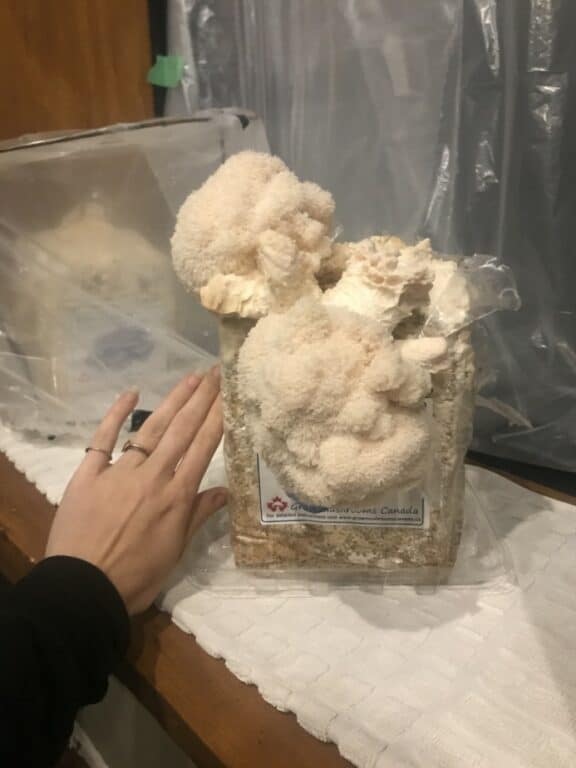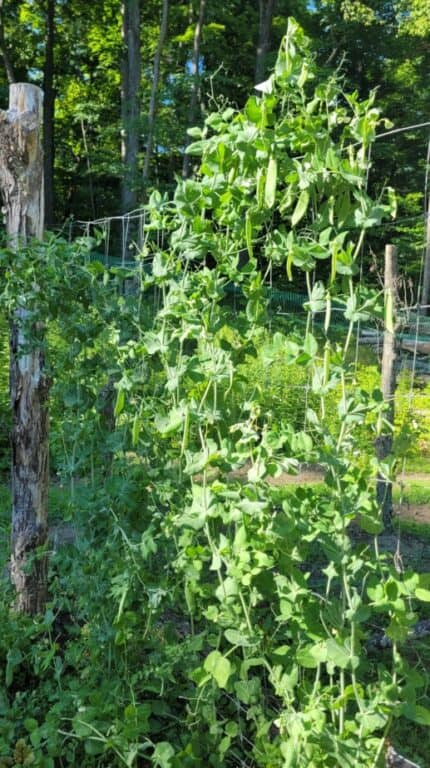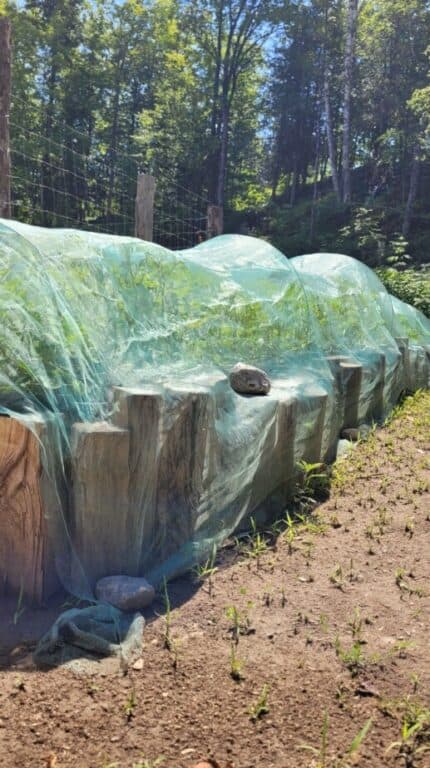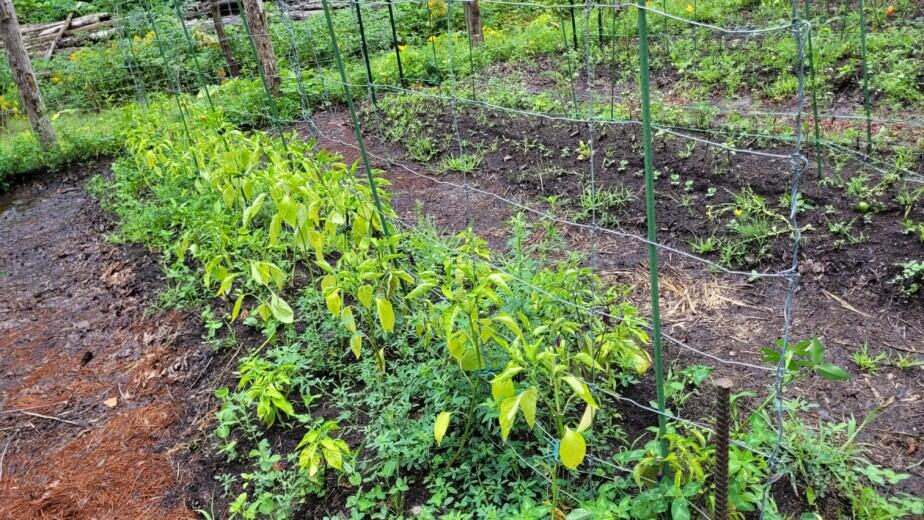This post may contain affiliate links. If you use these links to buy something we may earn a commission. Thanks.
Whether your metal fencing is old or excessive and left over; multiple functions can be made with both.
With grazing deer on the loose, we ordered more than enough garden fence because falling short wasn’t an option. Our left over fencing was quickly turned into a dozen different things we needed anyway.
In this article, you’ll find good uses for old fence panels, what to do with left over chainlink fence, numerous ways on how to reuse metal fencing, and the best thing you can do with an old metal fence if none of these ideas work for you.
Looking for a new fence? The Best Fence to Keep Deer Out
Make mushroom tents to maintain humidity
Left over steel fencing has sturdy wire that can be used for making lightweight frames.
You’ll need a humidity tent to grow gourmet mushroom kits indoors. Without proper humidity levels you won’t get fruit (mushrooms).
Instead of purchasing a tent; reuse materials you already have to make a frame and line with any opaque plastic bag.

Thanks to these simple DIY humidity tents, we’ve enjoyed plenty of fresh lion’s mane and oyster mushrooms.
To make the frame:
- you’ll need wire cutters to cut manageable pieces for the size of frame you want to make
- And pliers to bend the wire and secure it together
That’s it!
Why Grow Mushrooms at Home? 8 Practical Motives
Cut the wire into lengths as ready-to-use steel ties
Skip the zip ties! Once you cut your old metal fencing into steel ties, you’re going to find places to use them eventually.
I’ve used them to:
- secure fencing onto metal posts
- dry big bundles of sunflowers by securing them together and then shaping the excess into a hook to hang
- Snake a drain
- “lock” suitcase zippers together
- support live plants
- use in place of a carabiner (safely!) when I don’t have any more
- Close large bags
- and they could be used to pick some locks
More purposes for these steel wire ties are naturally explained throughout this post!
Use as a “tall telephone” pea trellis
“Tall telephone” peas grow super and tall; and tall is old fencing! As you can see, our peas surpassed 7 feet, but what else would have made such a height-appropraite trellis? Sticks perhaps but fencing was much easier.

A simple trellis like this is the best way to use old metal fence panels. It can lean on a structure or be stood upright with posts in the ground
Use up long lengths as full arbors
Speaking of trellises, old or left over fencing (in good shape) can make simple arbors. All you need are 2-4 T-posts to weave through and stick in the ground for the classic garden arbor.
Tall plants such as tomatoes, melons, squashes, peas, hardy kiwi vines, grapes, and more can be harvested from below as you walk under.
To make the arbor you wan to consider the best height and width for you. 14-16-foot fencing sections are long enough to arch-over for enough walking space under and between. One T-posts can be used used on either side of the arch to anchor it into the ground, but it’s more stable to have two T-posts on each side.
Use small sections as a lattice to top an arbor
Old fencing panels are a manageable size for this use. 4×4-foot or similar dimensions can easily be repurposed as a topper to an arbor. An arbor frame could use side and roof lattice for plant supports, especially fruit.
The lattice can be secured in place with repurposed steel wire ties from old fencing.
Make hoops to float row covers and shade cloth
Proper 3/4-inch thick conduit are super expensive to buy for making structural row cover hoops these days. Old fencing as wire hoops may not hold a row cover up against heavy snow fall, but they will hold shade or insect nets in summer.
Because these are thin wire hoops, they’re easy to stab into pots of any size with minimal root disturbance.
Repurposed steel for hoop supports are always better than PVC which will inevitably end up petrified, cracked, and in the garbage.

Our potatoes in pots were getting extremely hot in the sun until I surrounded the black pots with firewood and covered them with a shade cloth—thanks to the cut up old steel fencing as hoops.
Insect netting row covers are an essential for growing brassicas. They keep them cool and untouched by caterpillars which has turned a difficult crop into an easy one!

This article was originally published on foodforestliving.com. If it is now published on any other site, it was done without permission from the copyright owner.
I am using 12-gauge steel wire for my row covers, but you can make double-wide cut pieces out of excess fence material too.
When you do cut old fencing for hoops—don’t bend them! Keep them pin straight so they remain stronger.
Weave stakes through as a row trellis
Sturdy trellising isn’t always easy to set up, take down, or carry—but this is! Another way to use long sections of old fencing is as a row trellis. These are super easy to set up, take down, and carry. We used them for rows of peppers and cucumbers!

To make it: how ever long you want your row to be, cut it to that length. Roll it out flat on the ground, then every 4-6 feet weave a stake through, roll it up and secure it with one of those steel ties!
From here, store it aside until ready to use, or carry it to the row with a mallet hammer. Roll it out and pound each stake into the ground and voila! An easy and very sturdy trellis to set up and take down.
Repurpose as an enclosure or re-inforcement for animals
Okay, this would still be using your fence as a fence… But maybe you’ll need it for animals you want soon?
If you think anything else might need a fence, you might as well keep the old material if you have a spot out of the way to store it.

If you have a chicken coop, it wouldn’t hurt to reinforce the windows with steel fencing for added protection against bears or bobcats.
Lay down to deter deer from the fence line
If you’re putting up a new fence and looks don’t have to matter, old fencing is a great deer deterrent when laying on the ground.
Deer don’t like to walk on things that tangle their feet, move around, or feel unstable.
This is especially effective if the height of your new fence is somewhat insufficient. Laying the old fence on the ground increases the width they would have to jump if they did attempt. This decreases the likelihood of them even wanting to try. Their poor depth perception makes it difficult to tell how far the jump is.
Cut the wire into small pieces for S-hooks
The same way you cut the wire for steel ties—you can make them about 4-5 inches long and bend them into S-hooks.
S-hooks are useful for all kinds of things:
- hanging potted plants
- hanging herb bundles to dry
- hanging mugs
- hanging just about anything
- a simple hook to open and close a fence without a proper door
Encircle for a leaf mold maker
Leaf mold is a free and easy amendment for any type of garden. With old chainlink or high-tensile deer fencing you now have a way to pile more leaves in less space. With the old fencing; make a circle cage to hold in the leaves.
Chicken wire is more effective at containing leaves because the mesh is a tighter fit that a fence. But if you don’t have chicken wire for the job and you do have excessive fencing; then put two layers together. Off-set them so the holes are a reasonable size.
Cover the leaf pile with straw or evergreen clippings to retain moisture. If you can aerate the pile once in a while it will compost quicker. Either way, leaves will be effectively contained and composted by next spring.
Mulch vs Compost vs Fertilizer (When to Use What)
Sell it locally or make an online listing
Throwing such valuable material in the landfill is the worst thing you can do.
So the best way to reuse your old metal fencing if you don’t have any need for it, is to sell it.
I have personally bought fencing from Facebook marketplace multiple times. I find it to be the most useful marketplace, especially for selling my own items.
If you don’t wish to have access to Facebook market place, your other options include:
- A neighborhood in-person garage sale
- Noticing anyone starting a new garden and asking if they would like a free or cost-effective fence from you
- List it on Kijiji, eBay, or craigslist
Did I miss anything? Leave a comment if you gained something or have new ideas to share for everyone to read!
Recent Posts
There’s no shortage of full-sun ground covers for zone 4 climates! Each plant in this list can withstand the frigid temperatures and also enjoy the hot sun in summer. Full sun means that a plant...
There's no shortage of full sun ground covers, not even in zone 3! Zone 3 climates offer hot but short-lived summers and very cold winters. So each plant in this list can withstand the frigid...
